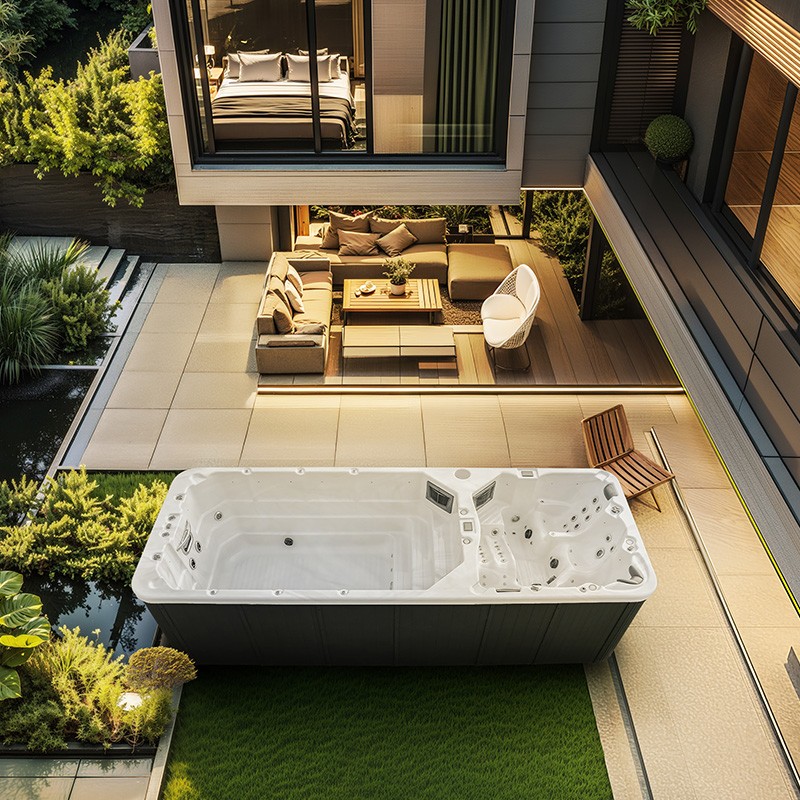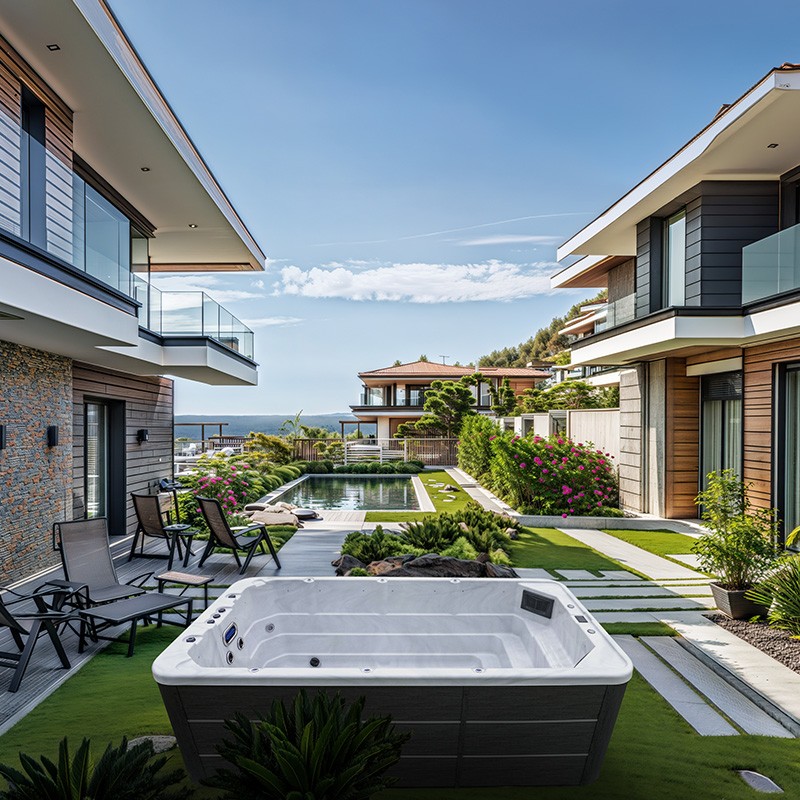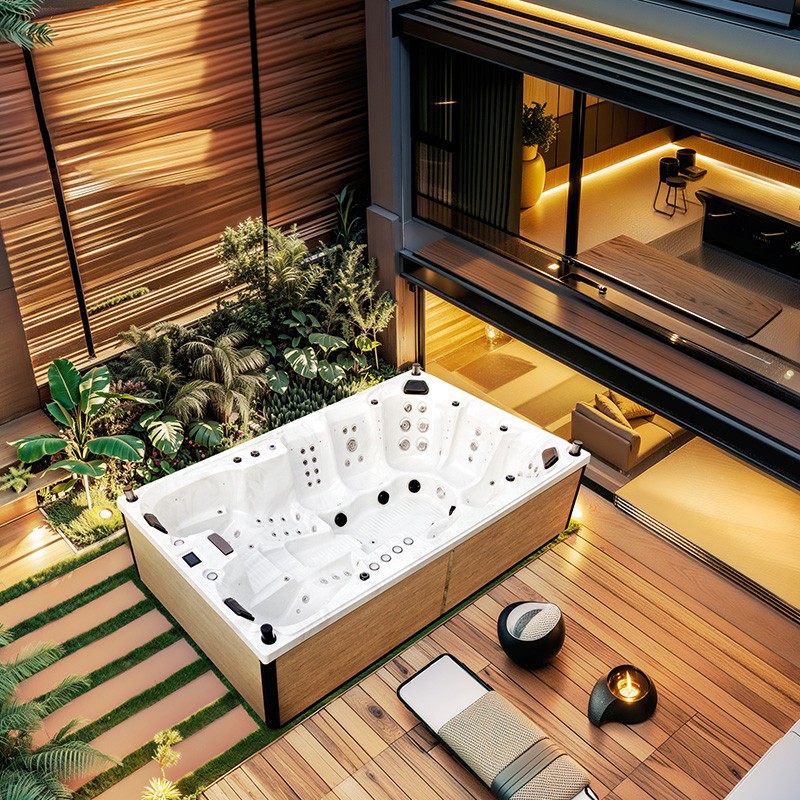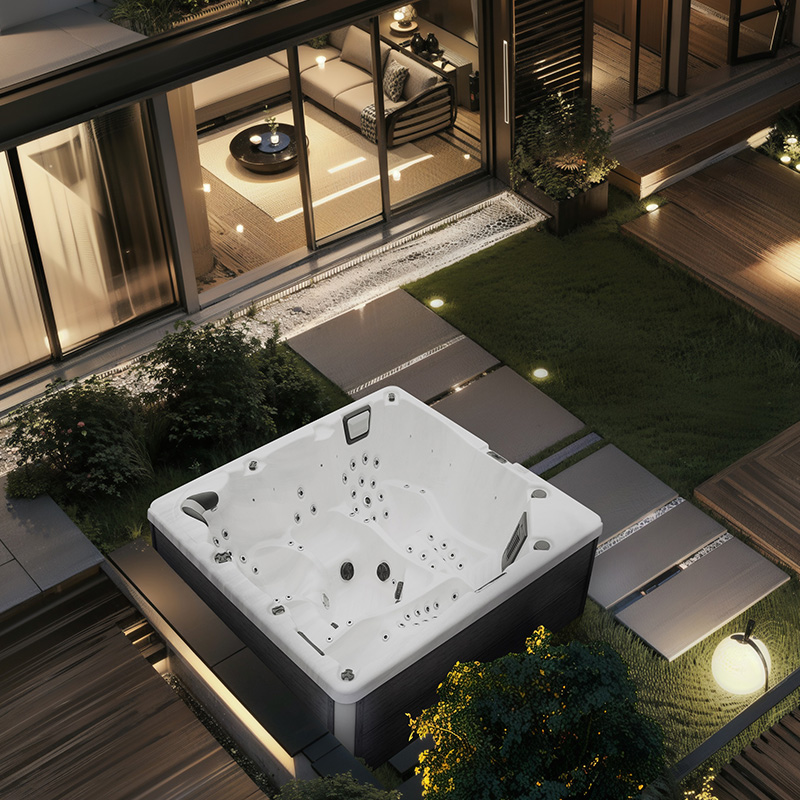
Are outdoor spa hot tubs easily deformed?
2025-08-18 15:35Whether enjoying a leisurely bath or enjoying the comfort of a spa massage, outdoor spa hot tubs have gradually become an indispensable part of the home. However, when purchasing and using outdoor spa hot tubs, many consumers have concerns about their durability, durability, and the risk of deformation after long-term use.
Particularly in outdoor environments, climate change, temperature fluctuations, and the stress of daily use can all affect spa hot tubs. So, are the materials used in outdoor spa hot tubs easily deformed?
This article will address this question, analyzing the characteristics of common materials used in outdoor spa hot tubs, exploring their resistance to deformation, and providing some maintenance and care recommendations.
Common Materials for Outdoor Spa Hot Tubs?
First, we need to understand the common materials used in outdoor spa hot tubs. Depending on the design and needs, outdoor spa hot tubs are made of a variety of materials, mainly including the following:
• Acrylic: Acrylic is one of the most common spa hot tub materials on the market. Its advantages include high transparency, good gloss, a strong texture, and easy molding, allowing for great flexibility in shape and design. Acrylic bathtubs are typically manufactured through heat pressing or vacuum forming processes and offer excellent UV resistance and strong corrosion resistance.
• Fiberglass: Fiberglass is another common material with strong compressive strength and impact resistance. Fiberglass bathtubs typically use different materials for the inner and outer layers, with the outer layer typically made of fiberglass-reinforced plastic, which offers greater durability.
• Wooden: Some high-end outdoor spa hot tubs are primarily constructed from wood, such as cedar and redwood. The natural appearance and comfort of wood make this type of bathtub popular with some consumers. However, wooden bathtubs require additional care to prevent moisture penetration and rot.
• Stainless Steel: Stainless steel bathtubs are often used in modern, high-end designs and offer high corrosion resistance and strength. However, metal is more susceptible to temperature fluctuations than other materials and may deform due to expansion and contraction. • Composite: Composite materials are typically made from a combination of multiple materials, such as resin and fiberglass. These materials offer greater strength and durability than single materials alone, and they also offer excellent UV and corrosion resistance.
Is the material of an outdoor spa hot tub prone to deformation?
When purchasing and using an outdoor spa hot tub, one of the most pressing concerns for consumers is material deformation. Deformation can negatively impact the appearance, structural stability, and lifespan of an outdoor spa hot tub. So, is the material of an outdoor spa hot tub prone to deformation? We need to analyze the following aspects:
1. Material Resistance to Thermal Expansion
Because outdoor spa hot tubs frequently heat water, the tub material must possess excellent high-temperature resistance. Different materials expand to varying degrees when exposed to heat. If the material expands under prolonged high-temperature conditions and lacks the ability to recover, it may deform.
• Acrylic: Acrylic has good heat resistance, but may experience slight thermal expansion in high-temperature environments. Generally, acrylic doesn't deform significantly when heated, but it may exhibit slight surface distortion or shrinkage if exposed to extreme heat for extended periods. However, modern acrylic bathtubs are designed and manufactured with this in mind, so this deformation doesn't significantly impact their structure.
• Fiberglass-reinforced plastic: Fiberglass itself has excellent heat resistance and a low coefficient of thermal expansion, making it less susceptible to deformation during heating. However, if the plastic layer surrounding the fiberglass is of poor quality or improperly applied, deformation may occur, especially with prolonged exposure to sunlight.
• Wooden bathtubs: Wooden bathtubs are more susceptible to deformation. Wood expands and contracts when exposed to hot water, and in environments with high humidity fluctuations, moisture penetration can cause deformation. To prevent this, wooden bathtubs require regular maintenance and treatment to keep the wood dry and stable.
• Stainless steel: Stainless steel has good heat resistance, but it does expand to some extent with temperature fluctuations. Although stainless steel is strong, temperature differences can cause minor deformation in welds or seams if not designed properly.
• Composite materials: Composite materials typically combine multiple materials to achieve a balance of strength and high-temperature resistance. Compared to single materials, composite materials have relatively low thermal expansion characteristics, thus reducing the risk of deformation.
2. Environmental Impacts on Materials
Outdoor spa hot tubs are often exposed to the elements, including sunlight, wind, rain, and cold. The long-term effects of these environmental factors on the material may also cause deformation. Ultraviolet rays, wind, sand, and moisture can all adversely affect the tub's material.
• Ultraviolet radiation: Ultraviolet rays accelerate the aging of materials, especially acrylic. Prolonged exposure to strong sunlight can cause cracks, discoloration, and even deformation. Therefore, outdoor spa hot tubs are typically coated with a UV-resistant protective layer to mitigate the effects of UV rays.
• Humidity and Temperature Fluctuations: Wooden bathtubs are particularly susceptible to changes in humidity and temperature. Extremely high or low temperatures can cause the wood to expand or contract, leading to deformation. To prevent this, wooden bathtubs should be regularly waterproofed and protected from prolonged exposure to extreme weather conditions.
• Corrosion and Oxidation: Metal materials, such as stainless steel and other metal alloys, can oxidize and corrode when exposed to moisture over time. Corrosion not only affects aesthetics but can also weaken the material's structural strength, causing deformation.
3. Daily Use and Maintenance
In addition to environmental factors, the pressure of daily use can also affect the degree of deformation in outdoor spa hot tubs. This is especially true when multiple people use the spa hot tub or the water level is high for extended periods. Excessive load and pressure can exacerbate material deformation.
• Overload: Prolonged use exceeding the maximum load capacity or failing to adjust the water level for extended periods can cause uneven stress on the material, leading to deformation.
• Cleaning and Maintenance: Regular cleaning and maintenance are crucial to extending the life of the tub. If dirt or scale accumulates on the tub surface, improper cleaning can affect its smoothness and strength, increasing the risk of deformation.
How to Prevent Outdoor Spa Hot Tub Deformation?
After understanding the potential deformation risks associated with different spa hot tub materials, consumers can take steps to reduce this risk and ensure the long-term performance of the tub.
• Selecting High-Quality Materials: When choosing an outdoor spa hot tub, it is recommended to select high-quality materials with heat, UV, and corrosion resistance. For example, acrylic bathtubs should be UV-treated, while wooden bathtubs should be made of wood that has been treated for water and corrosion.
• Proper Use and Maintenance: Avoid overloading your spa hot tub. Try to avoid having too many people in the tub or exceeding the designed water level. Additionally, the tub should be cleaned regularly, especially the pump, jets, and filtration system, to ensure there is no buildup of dirt that could damage the structure.
• Covering and Protection: When not in use, it's best to use a bathtub cover to reduce the effects of external environmental factors (such as sunlight and rain).
• Regular Inspection and Maintenance: Regularly inspect the tub's structure and exterior for cracks, discoloration, or minor deformation. Any abnormalities should be addressed promptly. For example, for wooden bathtubs, wood wax oil can be used to maintain the tub and reduce moisture damage.
What types of spa and hot tub models do you offer?
We offer an extensive range of spa products to suit both personal and commercial applications. Our collection includes outdoor hot tubs, massage spas, swim spas, in-ground spas, and family-sized spa tubs, all available for customization and bulk orders. Each model is designed with comfort, performance, and energy efficiency in mind.
As an experienced spa manufacturer and supplier, we provide low price options without compromising on features or aesthetics. Check out our catalog and let us help you select the perfect model for your business or home use.




